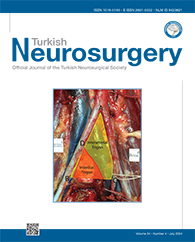2Korea University Guro Hospital, Korea University College of Medicine, Department of Neurosurgery, Seoul, Korea
3Asan Medical Center, University of Ulsan College of Medicine, Department of Anesthesiology, Seoul, Korea
4Asan Medical Center, University of Ulsan College of Medicine, Department of Neurosurgery, Seoul, Korea DOI : 10.5137/1019-5149.JTN.44994-23.2 AIM: To share our clinical insights into octogenarian patients with unruptured intracranial aneurysms (UIAs) and evaluate the treatment strategies for this demographic.
MATERIAL and METHODS: A retrospective analysis was conducted on data from 134 patients with a follow-up exceeding 6 months, all enrolled in this study. We assessed the incidence rates (IRs) of aneurysm growth and rupture, along with potential predictors of aneurysm growth.
RESULTS: Among the 134 patients, 99 (73.9%) underwent conservative management, 25 (18.7%) received coiling, and 10 (7.5%) underwent clipping. The mean age of the cohort was 81.8 years. The middle cerebral artery was the most common location for aneurysms. The mean aneurysm size was 4.9 mm, with sizes significantly larger in the treatment groups (coiling and clipping) compared to the observation group (4.4 mm in the observation group; 5.9 and 7.4 mm in the coiling and clipping groups, respectively). The proportion of aneurysms with a daughter sac was higher in the treatment groups compared to the observation group (6.1% vs. 44% [coiling] and 50% [clipping]). The IR of aneurysm growth was 5.9 per 100 person-years, and that of aneurysm rupture was 0.8 per 100 person-years. No factors were statistically significant for aneurysm growth.
CONCLUSION: Age alone, especially in individuals over 80 years old, may not be a contraindication for UIA treatment. We recommend considering treatment in octogenarians with high-risk aneurysm features, such as a large aneurysm and the presence of a daughter sac, as the complication rates are low.
Keywords : Octogenarians, Unruptured aneurysms, Intracranial aneurysms, Treatment




